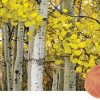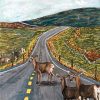An essay
Sunlight and wind circled me, a girl looking out over the Red Desert and the small stream below. Perched next to a gnarled, twisted juniper that had been dead for my entire life, I sat at the edge of the draw that held the green meadow where my family had been camping since before I was born. I could look down into that meadow, onto the stream ribboning through the plump thickets of willows. I could see the old line shack tilting at the top of the meadow, a dilapidated, wooden structure that had once housed sheepherders for the summer. Farther downstream, I could see our fire ring, set into the flat earth just before the canyon walls pinched in. I could see our backpacking tents—mine, my brother’s, our parents’. Our mother reclined in a camp chair with a book open on her knee, our father chipped golf balls, and our family Labrador chased them into the long grass.
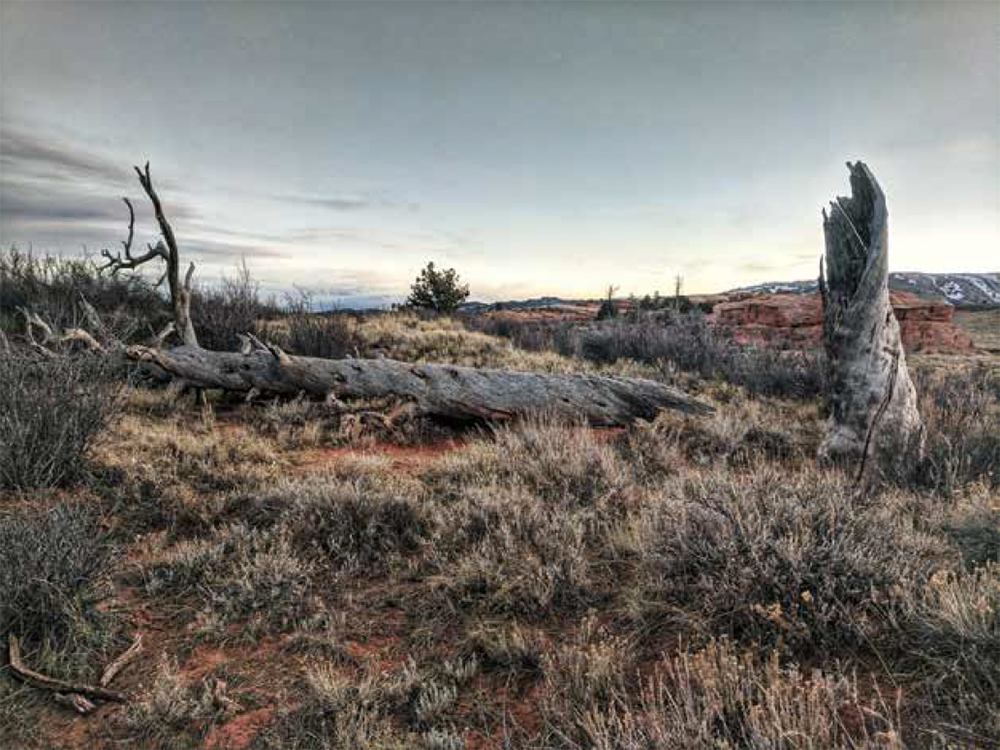
And, when I looked up and across the draw, I could see the sweep of the desert going on to Oregon Buttes and the edge of the world. I could see all that sage, the faint threads of two-track roads winding through it, the hint of the Sweetwater River’s canyon, just a shadow interrupting the misleading flatness of that land.
It was easy to think it existed just for us, my family of four. It was easy to breathe in the tang of sage and the faint dampness of the creek far below and to know that it belonged to me.
![]()
But did it belong to me, to my family? Yes, and no.
Like so much of the West, most of the Red Desert, including our meadow, is public land. As members of the public, we owned it in a sense, along with other members of the public. But we also laid claim to it, as many Westerners have done with many pieces of land over the years, through the time we spent there—the days and weeks that revealed to us the temperament of the stream, the patterns of the wind during calmness and storm, the shape of shadows in all seasons.
It did not matter to me that the camp was public land, not when I was very young. My family began hunting antelope and camping in Wyoming’s Red Desert when my father’s father was a boy. My parents, my uncles, and my aunt discovered our camp in the early 1980s, before my brother and I were born. My brother was eight weeks old the first time my parents took him to the camp, and I was six weeks old for my first trip. This was a land of dust and wind and distant horizons, a land that tourists rushing past on the interstate would likely compare to the moon. From our front door in Rawlins, the trip to the desert swallowed one hundred miles and three hours, most of it on dirt roads. We rarely saw anyone else on our way to the camp, never shared the meadow with other outdoorsmen. It seemed our very own oasis, our family secret.
But the story of ownership of that meadow is complicated. The meadow is, in legal fact, part federal land and part state land. These governments follow different management principles. Federal agencies like the Bureau of Land Management (BLM) manage most of the land under their care according to the doctrine of multiple use. However, the Wyoming State Board of Land Commissioners must utilize state lands to raise funds for state institutions. I always wondered why these lands were commonly referred to as “school sections” and learned as an adult that schools were prominently named in the grants that originally transferred land from the federal government to the state for fundraising purposes. It seems more direct to simply call them “state trust lands” or “state lands,” though I am partial to the hidden narrative behind the name “school section.”
Until 1988, the state limited access to its lands to those who held grazing leases. When they expanded the statutes to include recreational day use, like hiking, hunting, and fishing, the board addressed the concerns of grazing lessees by specifically prohibiting overnight camping and campfires. I do not know whether this prohibition limits damage done to state lands by careless users. I do know many families who, like my own, had formed deep connections to state land and camped on parcels that belonged to the state, knowingly or unknowingly, and that the state rarely intervened unless grazing lessees complained.
As a child, I did not understand that the meadow was bifurcated, split between the BLM and the state. It was a line we could not see, for there was no marker. As I grew older, I noticed that my parents, who regularly studied the maps, knew that the line existed. But it was tricky to name exactly where it was. The only landmark on the map was the creek, which redefined its banks every year during spring run-off. We would learn later that the bend that my parents thought marked the divide between state land at the top of the meadow and BLM land at the bottom was not the bend reflected on the map. But because our little corner of the Red Desert was largely unknown, or at least ignored at that time, the exact location of the line seemed unimportant.
![]()
Wind and snow circled the old juniper, and I pressed my palm to the tree’s roughened skin. An early spring storm blew around me, drifting white in draws and coulees of the desert. I was a young woman, just graduated from the University of Wyoming, and my boyfriend, Rob, stood with his arm around me. Except, now he was my fiancé—he had moments before knelt in the dust by the tree and asked me to marry him. With my boots against the gritty earth, I looked into his green eyes and felt something settle into place. I felt the cool gold of the unfamiliar ring warming on my left hand and looked out over land that I knew by heart—the desert sweeping away toward the silhouette of the Wind River Mountains, the land falling away into the creek’s draw, the meadow spreading green and wet with snow-melt below.
But the meadow looked different. The line shack slouched at the top of the flat, nearly collapsed in on itself rather than standing upright. My family’s tents crowded together downstream, just above the steep, narrow pitch of the creek’s canyon rather than circled around the fire ring. Though Rob and I would celebrate with our families that night, I would miss the familiar set of the canyon as viewed from the fire, the clean view of the line shack upstream and the tree above. From our new, makeshift camp, we could not see the shack—it was veiled by thick willows, hidden. It was as if my world had been shifted a quarter turn, and nothing was quite where I had always known it to be. As I began to reorient myself, to find my bearings, I struggled to reconcile the old ways with the new.
![]()
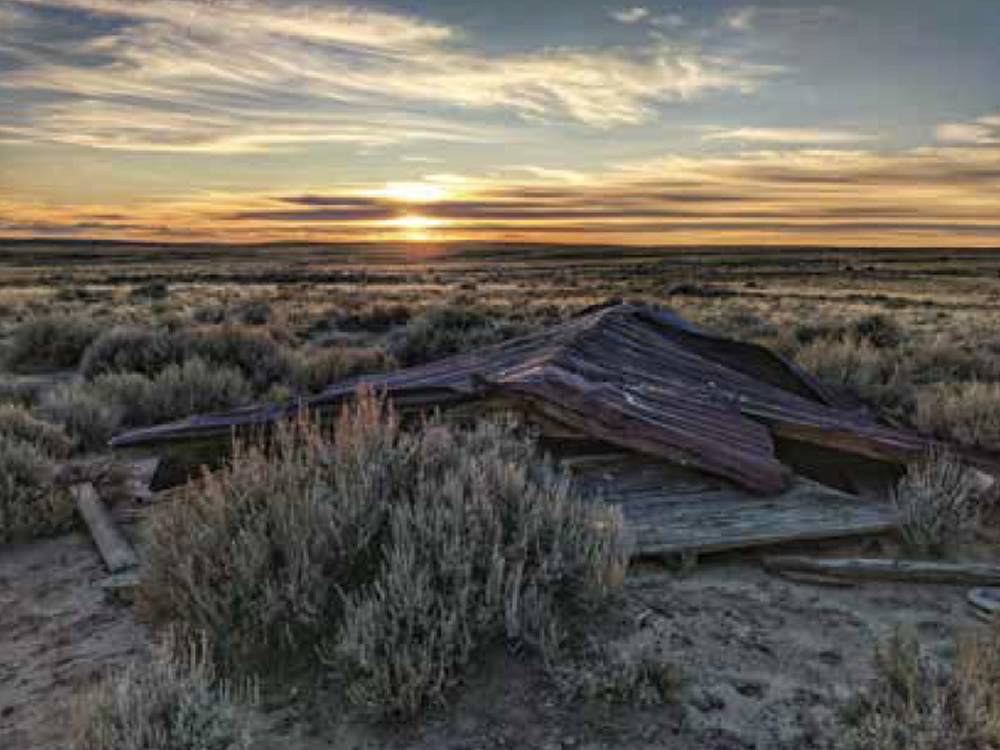
That line between BLM and state land had grown heavy since I was a child, and it weighed now on my sense of belonging, of ownership. In 2006, two years before Rob proposed, the State Legislature amended land-use statutes. The amendments aimed to both educate the public about and enforce the 1988 rules for public use of state lands. Restrictions on recreational use came under increased scrutiny, and game wardens and other law enforcement officers began issuing verbal warnings for violations like driving off-road or building a campfire. We were among the many families notified that our generational camp had been illegally set up on state land, where overnight camping and campfires were prohibited.
Perhaps we were lucky to have just received a warning, because the new statutes allowed for violators to be charged with misdemeanors and levied with fines of up to $750 or even sentenced to jail time. But we did not feel lucky to discover that a place we thought we knew had shifted beneath our feet, become unstable, threatened to unbalance us. The sliver of BLM land where camping was legal was small, just wide enough for our tents but not to park our vehicles, and we worried that we would again be in violation of the state regulations. We began making phone calls, reading statutes, looking for a way to save the old camp, the original fire ring. We hesitated to build a new fire ring on BLM land, not wanting to dig into the tender grass of the meadow without cause.
Looking back, I suppose I should have known, even as a child, just how many people had claims to that place. We knew the local ranching families who owned grazing leases throughout the part of the Red Desert where we camped. And we knew that sheep ranching claimed space and history in the desert—the old line shack was a relic of this history, and we often drove through crowds of woolly ewes and lambs in Bison Basin on our way to camp. We were safe in the desert, but we knew better than to get out of the truck near a sheep camp protected by the Great Pyrenees dogs that snapped and barked at our tires as we passed.
Through my middle school and high school years, we began to see more activity in the desert. Recreationists in side-by-sides, arrowhead and shed-antler hunters, fishermen on the Sweetwater River. We also found that drawing antelope tags in our favorite areas became difficult as more and more people entered the lottery. And then there was the Continental Divide Trail. What we once registered only as a series of markers along dirt roads became a major attraction for hikers, and we began running into people who identified themselves with trail names rather than real names and who called us “trail angels” for offering them cold water, soda, or beer. (If they had known how my father cursed when he saw them, how he bemoaned the fact that we’d have to “go back to town to get away from all the damned people,” I doubt they would have called us angels.)
At the same time, the increased drilling in the nearby Jack Morrow Hills and elsewhere in the desert brought not only new wells and rigs, but a peak in interest from environmental groups. Suddenly, the place I had always considered one of the lower forty-eight’s best-kept secrets was being featured in magazines, newspapers, and photography installations throughout the state and even nationally. I feared that others would find it, lay claim to it, take it from me.
![]()
Wind and dust circled me, and I dropped my eyes to the white glint of a stone by my boot. I stooped and plucked from the desert a piece of worked rock, an arrowhead or a spear-point. The shoulders had snapped off, but the point itself was beautiful, uniform. I imagined the disappointment its maker might have felt, watching something so close to taking shape suddenly falling to pieces in his hands. I closed it in my palm and continued my hike to the old juniper at the top of the stream’s canyon.
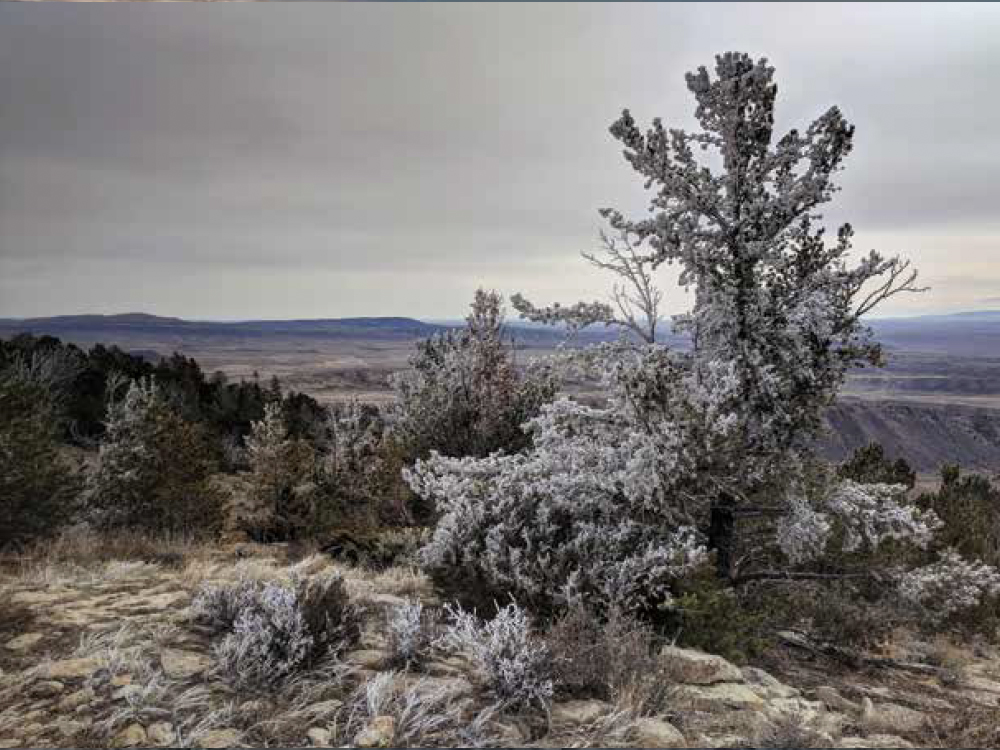
I looked down at the meadow, looked out across the desert. So much had changed in the years since Rob asked me to marry him. We had recently returned to the desert after I completed graduate school a state away in Idaho, and, while we were gone, my family had successfully applied for a special-use lease that allowed us to make a legal claim to the meadow. The lease came with two stipulations: we could not prevent other people from using the meadow, and we had to build a cabin. Though Rob and I helped as much as we could, a great deal of the construction had occurred while we were in Idaho. How strange it was to stand at the top of the draw, look down at the meadow and see a solid, new cabin there. And how strange to know that, though we owned the cabin, we still did not own the land.
We had chosen to build where the old line shack had stood rather than at the far end of the meadow by the traditional fire ring. We believed that doing so would save the soft riparian land from being chewed up by the heavy loads and frequent truck traffic involved in building the cabin. We also agreed that building at the site of the old shack, where a structure had stood for years, would leave the majority of the meadow unchanged.
Though we thought we would trek the quarter of a mile downstream to build our fires in the old ring, we rarely did. It was easier to buy a fire-pan and set it up near the cabin. The fire ring we circled when I was a child now sat cold and dark most of the year, and grass began to grow up around the stones. I grieved the loss of that tradition, even though I recognized that we had simply relocated to the top of the meadow. As I stood next to the juniper with the spear-point in my hand, I felt the whisper of a loss I could only begin to understand, as if my own grief for the place I had known as a child was a receding echo of something richer, deeper. I wondered how much the land itself had changed in the years since the spear-point’s creation. The creek shifting, cutting new banks into the soft meadow, trees sprouting from the rocky soil, then dying and falling, the wind eroding rock, sculpting new forms. Dirt roads beaten into the sage, oil wells sunk into the earth, fences spiked into the ground.
Yet the land endured, like that juniper with its roots clinging to the rock and its branches open to the sky. My family’s history with the place was but one story mapped there. The land held stories of so many people, of so many years. Our fire ring will continue to fade, and someday the cabin will fall or be torn down, just like the line shack that preceded it.
I knew as I held the spearpoint and looked over the desert that the land had shaped me more than I had shaped it, and that although it did not belong to me, I belonged to it. And I felt a kinship to all the desert’s children, to those who loved it and grieved it and made their livings from it, to all who carried stone, wind, sun, snow, and sage in their blood.
By Ann Stebner Steele
Photos by Eric Krszjzaniek
Ann Stebner Steele is a writer of literary fiction and nonfiction and a lecturer and advisor with the University of Wyoming Honors College. Find more of her work at annstebnersteele.com.

